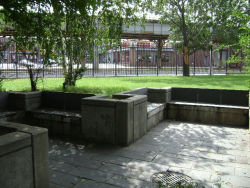Harmony Park
Harmony Park
What was here before?
This park is in the historic Brooklyn neighborhood of Bedford-Stuyvesant. Once known as Bedford Corners and Stuyvesant Heights, the Dutch farmed the area during the 17th and 18th centuries. In 1790, more than one quarter of the residents were African American, the majority of them enslaved. Following the abolition of slavery in New York state in 1827, formerly enslaved persons purchased land and built homes in Bedford and the bordering neighborhoods of Weeksville and Carrville, creating some of America’s earliest free Black communities.
With the arrival of the Brooklyn and Jamaica Railroad at Atlantic Street in 1836 and the opening of the Brooklyn Bridge in 1883, these neighborhoods became more closely linked to other parts of the city. Their populations expanded in number and diversity. By the latter part of the 19th century, there were Dutch-American, Scottish, Irish, German, Jewish, and African American residents. Bedford-Stuyvesant remains a cornerstone of the city’s African American community.
How did this site become a park?
Once a vacant lot, this park was created through a partnership between the local Fulton Park Homeowners Association and the NYC Department of Housing Preservation and Development (HPD) in 1990 and later transferred to NYC Parks.
As part of the Open Spaces Program, this site was among many selected by a panel of HPD planners and architects, community groups, churches, and elected officials who identified vacant city-owned parcels suitable for open space. In 1990-91, the park was built with city funds and was maintained by the Fulton Park Homeowners Association for the next seven years. In 1997, the property was transferred to NYC Parks, which now maintains the park with the help of a community of volunteers.
Check out your park's Vital Signs
Clean & Safe
Green & Resilient
Empowered & Engaged Users
Share your feedback or learn more about how this park is part of a
Vital Park System



